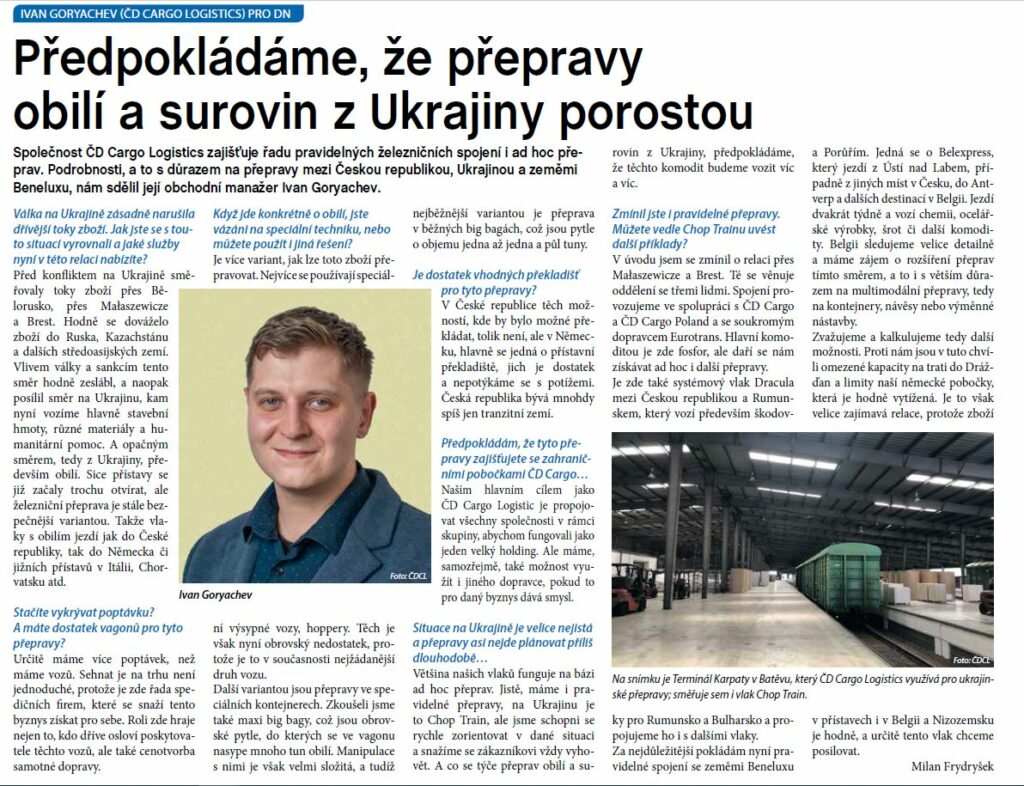
Just published in Dopravní noviny no. 16 – 17
News
Ivan Goryachev (ČD Cargo Logistics): we expect grain and raw material shipments from Ukraine to grow
August 2, 2024, Milan Frydryšek
22.8. – Společnost ČD Cargo Logistics zajišťuje řadu pravidelných železničních spojení i ad hoc přeprav. Podrobnosti, a to s důrazem na přepravy mezi Českou republikou, Ukrajinou a zeměmi Beneluxu, nám sdělil její obchodní manažer Ivan Goryachev.
The war in Ukraine has fundamentally disrupted previous flows of goods. How did you cope with this situation and what services do you now offer in this session?
Prior to the conflict in Ukraine, goods flows were routed through Belarus, via Malaszewicze and Brest. A lot of goods were imported to Russia, Kazakhstan and other Central Asian countries. As a result of the war and the sanctions, this direction has weakened a lot, and on the contrary, the direction to Ukraine has strengthened, where we are now mainly transporting building materials, various materials and humanitarian aid. In the other direction, that is, from Ukraine, it is mainly grain. Although the ports have started to open up a little, rail transport is still the safer option. So there are trains with grain both to the Czech Republic and to Germany or to the southern ports in Italy, Croatia, etc.
Can you keep up with the demand? And do you have enough wagons for these transports?
We certainly have more enquiries than we have cars. Getting them on the market is not easy because there are a number of freight forwarding companies trying to get this business for themselves. It is not only who approaches the providers of these vehicles first that plays a role here, but also the pricing of the transport itself.
When it comes to grain specifically, are you tied to a special technique or can you use other solutions?
There are several options for transporting these goods. The most used are special hoppers. However, there is now a huge shortage of these as they are the most in demand type of vehicle at the moment.
Another option is transport in special containers. We have also tried maxi big bags, which are huge sacks into which many tons of grain are packed in a wagon. However, they are very difficult to handle, so the most common option is to transport them in regular big bags, which are one to one and a half tonne bags.
Are there enough suitable transhipment points for these transports?
In the Czech Republic, there are not so many possibilities for transhipment, but in Germany, mainly port transhipment points, there are enough of them and we do not face any difficulties. The Czech Republic is often more of a transit country.
I assume that you arrange these transports with foreign branches of ČD Cargo…
Our main goal as ČD Cargo Logistic is to connect all companies within the group to operate as one big holding. But of course, we also have the option of using another carrier if it makes sense for the business.
The situation in Ukraine is very uncertain and the transports cannot be planned for the long term…
Most of our trains operate on an ad hoc basis. Sure, we have regular services, the Chop Train to Ukraine, but we are able to quickly navigate the situation and always try to accommodate the customer. And in terms of transporting grain and raw materials from Ukraine, we expect to carry more and more of these commodities.
You also mentioned regular transports. Can you give other examples besides Chop Train?
In the introduction, I mentioned the route via Małaszewicz and Brest. This is being handled by a three-man department. We operate the service in cooperation with ČD Cargo and ČD Cargo Poland. Various transports are carried out here.
There is also the Dracula system train between the Czech Republic and Romania, which carries mainly automotive goods for Romania and Bulgaria, and we are connecting it with other trains and adding other goods to the regular train.
The most important thing for me now is the regular connection with the Benelux countries and the Poor Countries. This is the Belexpress, which runs from Ústí nad Labem, or from other places in the Czech Republic, to Antwerp and other destinations in Belgium. It runs twice a week and carries a wide range of commodities.
We are watching Belgium very closely and are interested in expanding shipments in this direction, including with a greater emphasis on multimodal transport, i.e. containers, semi-trailers or swap bodies.
We are therefore considering and calculating other options. At the moment, we are up against limited capacity on the line to Dresden and the limits of our German branch, which is very busy. However, this is a very interesting route, because there is a lot of goods in the ports in Belgium and the Netherlands as well, and we definitely want to strengthen this train.
Milan Frydryšek
http://www.dnoviny.cz/spedice-logistika/ivan-goryachev-cd-cargo-logistics-predpokladame-ze-prepravy-obili-a-surovin-z-ukrajiny-porostou
